Athens–Piraeus Electric Railways
I.S.A.P. S.A. or Athens–Piraeus Electric Railways S.A. (Greek: Η.Σ.Α.Π. Α.Ε., Ηλεκτρικοί Σιδηρόδρομοι Αθηνών-Πειραιώς Α.Ε., Ilektrikoi Sidirodromoi Athinon-Pireos A.E.) was a company which operated the Piraeus - Kiffisia line from 1976 to 2011. Piraeus - Kifissia line was the oldest urban rapid transit system of Athens metropolitan area. The line opened in 1869 as a suburban railway line connecting Athens with its port of Piraeus and it was gradually converted to full rapid transit operations, making it one of the oldest metro lines in the world. The line which Isap S.A. operated evolved from the older Athens & Piraeus Railway and Lavrion Square-Strofyli railway.
| S.A. (corporation) | |
| Industry | Railway |
| Fate | Absorbed by STASY S.A. (2011) |
| Predecessor | Hellenic Electric Railways (ΕΗΣ) |
| Successor | STASY S.A. |
| Founded | 1976 |
| Defunct | 2011 |
| Headquarters | , |
Area served | Athens urban area |
| Services | Piraeus-Kifissia |
Number of employees | 1003 (May 2011) |
| Parent | OASA S.A. |
| Website | http://www.isap.gr |
In June 2011 ISAP S.A. was absorbed by a new transport company, STASY S.A.
History
Athens and Piraeus Railway Company
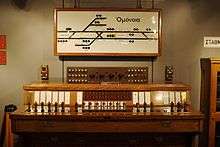
The line from Piraeus to Thision was inaugurated on February 27, 1869 as a steam train connecting Athens and its port, Piraeus, and was operated by Athens & Piraeus Railway Co (Greek: Σιδηρόδρομος Αθηνών-Πειραιώς or Greek: Σ.Α.Π. Α.Ε.). The project was considered important, so Queen Olga and the Prime Minister Thrasyvoulos Zaimis attended the inauguration ceremony. There were 8 trains in each direction daily and 9 trains in each direction on Sundays.
In 1874 the Athens & Piraeus Railway Company was bought by the Bank of Industrial Credit (Greek: Τράπεζα Βιομηχανικής Πίστεως). Under the new ownership the railway procured additional rolling stock. Soon the line was extended to Omonoia Square with an underground section constructed with the cut-and-cover method.
The line was electrified in 1904 using the 600 V DC, third rail, top contact system by Thomson Houston.
Hellenic Electric Railways Company
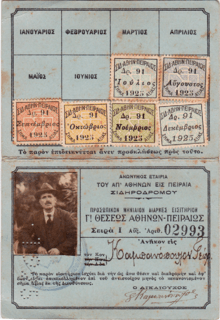
In 1926 the SAP S.A. was bought by the Power and Traction Finance Ltd and renamed Ellinikoi Ilektrikoi Sidirodromoi (E.I.S., Greek: Ελληνικοί Ηλεκτρικοί Σιδηρόδρόμοι or Greek: Ε.Η.Σ., translated as Hellenic Electric Railways).[1] In 1926 the sister company Ilektriki Etaireia Metaforon or H.E.M., also part of Power Group, took over the 1,000 mm (3 ft 3 3⁄8 in) metre gauge Lavrion Square-Strofyli railway. This line was eventually converted to standard gauge, double track and became an extension of the existing line, reaching Attiki in 1948 and Kifissia in 1958.
Athens-Piraeus Electric Railways
In 1976 E.I.S. was nationalized and renamed Athens-Piraeus Electric Railways S.A. (I.S.A.P).[2]
A merger of ISAP with Athens Metro was dictated by Law 2668 in 1998,[3] however it was postponed indefinitely and the required Presidential Decree was never issued. In January 2011 the Greek Government announced their plans to merge ISAP with Attiko Metro Etaireia Leitourgias S.A. (AMEL), the company which operates Athens Metro lines 2,3, and with Athens Tram S.A. in a single new company.[4]
In March 2011, the Greek Government passed Law 3920[5] to allow ISAP and Athens Tram to be absorbed by Attiko Metro Operations Company (AMEL). The new company created from the mergers is named "STASY S.A." (Greek: ΣΤΑΣΥ Α.Ε.) and is a subsidiary of OASA S.A. The merger was officially announced on June 10, 2011,.[6]
STASY is based at the former ISAP head offices, near Omonoia Square in Athens. Kostas Vassiliadis, a former chief engineer (1976-1991) and later CEO of ISAP between 1997 and 2000 became Chairman and CEO of the merged company until the end of 2012
Network and stations
| ISAP | ||||||||||||||||||||||||||||||||||||||||||||||||||||||||||||||||||||||||||||||||||||||||||||||||||||||||||||||||||||||||||||||||||||||||||||||||||||||||||||||||||||||||||||||||||||||||||||||||||||||||||||||||||||||||||||||||||||||||||||||||
|---|---|---|---|---|---|---|---|---|---|---|---|---|---|---|---|---|---|---|---|---|---|---|---|---|---|---|---|---|---|---|---|---|---|---|---|---|---|---|---|---|---|---|---|---|---|---|---|---|---|---|---|---|---|---|---|---|---|---|---|---|---|---|---|---|---|---|---|---|---|---|---|---|---|---|---|---|---|---|---|---|---|---|---|---|---|---|---|---|---|---|---|---|---|---|---|---|---|---|---|---|---|---|---|---|---|---|---|---|---|---|---|---|---|---|---|---|---|---|---|---|---|---|---|---|---|---|---|---|---|---|---|---|---|---|---|---|---|---|---|---|---|---|---|---|---|---|---|---|---|---|---|---|---|---|---|---|---|---|---|---|---|---|---|---|---|---|---|---|---|---|---|---|---|---|---|---|---|---|---|---|---|---|---|---|---|---|---|---|---|---|---|---|---|---|---|---|---|---|---|---|---|---|---|---|---|---|---|---|---|---|---|---|---|---|---|---|---|---|---|---|---|---|---|---|---|---|---|---|---|---|---|---|---|---|---|---|---|---|---|---|
| ||||||||||||||||||||||||||||||||||||||||||||||||||||||||||||||||||||||||||||||||||||||||||||||||||||||||||||||||||||||||||||||||||||||||||||||||||||||||||||||||||||||||||||||||||||||||||||||||||||||||||||||||||||||||||||||||||||||||||||||||
| ||||||||||||||||||||||||||||||||||||||||||||||||||||||||||||||||||||||||||||||||||||||||||||||||||||||||||||||||||||||||||||||||||||||||||||||||||||||||||||||||||||||||||||||||||||||||||||||||||||||||||||||||||||||||||||||||||||||||||||||||
Network
ISAP's line connected the port of Piraeus with the northern suburb of Kifissia. As it was originally designed for steam traction, the line runs mostly above ground. However, there are no level crossings. It is built to 1,435 mm (4 ft 8 1⁄2 in) standard gauge and is electrified using the 750 V DC, third rail, top contact system, also used by Athens Metro Lines 2 and 3. The two lines (ISAP and Metro Line 2) have a physical connection at Attiki station.
From Piraeus the line runs eastwards to Neo Faliro and then north to Thision. Between Monastiraki and Attiki the line runs underground. At Monastiraki passengers can change to Metro line 3 and at Omonoia and Attiki to Metro line 2. From Attiki the line continues north, following the alignment of the old Lavrion Square-Strofyli railway through Patissia, the suburbs of Nea Ionia, Irakleio, Marousi and terminates at Kifissia. At Nerantziotissa passengers can change to the suburban line Proastiakos serving Athens International Airport.
Stations
- Piraeus, next to the port, is the southernmost station of ISAP. The Electric Railways Museum of Piraeus, a small museum of urban transport (SAP, EIS, ISAP and former tram lines) is located in the station, at the former Post Office. A train depot and rolling stock repair facilities are located next to the station. Part of the station and most adjacent engine sheds and works were destroyed by Allied bombing during World War II, on January 11, 1944.
- Faliro, near Faliro Coastal Zone Olympic Complex (Peace and Friendship Stadium and Karaiskákis Stadium) and close to a terminal of Athens Tram S.E.F. (Σ.E.Φ.) The station includes a rolling stock depot.
- Moschato
- Kallithea
- Tavros, with a train reversing siding.
- Petralona
- Thiseio - The original terminus of the line when it opened in 1869. Next to the passenger station there is a train depot and the permanent way maintenance department, with some specialized departmental rolling stock.
- Monastiraki, passenger interchange with Athens Metro Line 3.
- Omonoia, passenger interchange with Athens Metro Line 2.
- Victoria
- Attiki, passenger interchange with Athens Metro Line 2. At this station there is also a small depot and the railway connection with the Athens Metro Line 2.
- Agios Nikolaos
- Kato Patissia
- Agios Eleftherios
- Ano Patissia, with a train reversing siding.
- Perissos
- Pefkakia
- Nea Ionia, with a train reversing siding.
- Heraklio, with a train reversing siding.
- Eirini, near the Athens Olympic Stadium. The signalling and control center for the ISAP line and a train washing facility are located next to the station.
- Nerantziotissa, passenger interchange with the Proastiakos suburban services. Near the Mall Athens.
- Maroussi
- KAT, near the KAT Hospital
- Kifissia, the northernmost terminus.
Rolling stock
Steam locomotives
In the early period (1869–1904) the railway used 22 steam tank locomotives of about 6 different types. The majority were of 2-4-0T configuration, made in the United Kingdom by Hudswell Clarke and Sharp Stewart.[7] After electrification, some the steam locomotives were sold to the Hellenic State Railways (SEK).[8]
| Name(s) | Type | Quantity | Manufacturer | Serial Nos. | Year | Notes |
|---|---|---|---|---|---|---|
| Constantine | 0-6-0T | 1 | Hudswell Clarke | 1868 | ||
| Olga, George | 2-4-0T | 2 | Hudswell Clarke | 1868 | ||
| 0-4-2T | 1 | Neilson & Co. | 1866 | |||
| 2-4-0T | 1 | Sharp Stewart | c.1878 | |||
| 2-4-0T | 6 | Sharp Stewart / Hudswell Clarke | 1879–1884 | |||
| 2-4-0T | 2 | Sharp Stewart | 1892 | |||
| Marina | 0-6-0ST | 1 | Manning Wardle | 1892 | to SEK 51, class Δα (1st) | |
| 4-4-0T | 2 | Neilson & Co. | 1892 | to SEK 301–302, later 21–22, class Γα | ||
| 0-4-2T | 3 | Saint-Léonard | 1896 | |||
First generation EMUs
Since electrification (1904) the railway used almost exclusively electric multiple unit (EMU) trains. The vehicles are classified in batches (or deliveries). The first four batches consisted of wooden passenger cars on iron or steel frames. Currently only a short train of two wooden railcars is preserved, modified with the addition of Scharfenberg couplers at each end and is displayed during special events.
| Batch | Year | Description | Photograph |
|---|---|---|---|
| 1st | Locomotive hauled stock | ||
| 2nd | 1904 | 40 railcars (20 DM and 20 T) made by Thomson Houston/Desouches David & Cie. Withdrawn in 1985. | 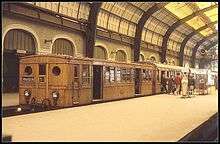 |
| 3rd | 1914 | 9 railcars made by Baume et Marpent/Desouches David & Cie. Withdrawn in 1985. | |
| 4th | 1923 | 12 railcars of the Baume et Marpent design, built at Piraeus Works. Withdrawn 1985. | |
| - | 1947–1948 | Rebuilding and modernization of damaged rolling stock | |
The first generation rolling stock was numbered as in the following table:[10]
| Marking | number | type |
|---|---|---|
| A1 to A11 | 11 | DT |
| Γ417 to Γ427 | 11 | DT |
| F410 to F418 | 18 | T |
| B601 to B621 | 21 | DM |
| Total | 61 | |
Second generation EMUs
The fifth (1951), sixth (1958) and seventh (1968) batches were of steel construction, made by Siemens-MAN. At the same time Scharfenberg couplers were introduced.
| Batch | Year | Configuration | Type | Numbering | Description | Photograph |
|---|---|---|---|---|---|---|
| 5th | 1951 | DM-DT or DM-DTL |
DM | 901-912 | 24 railcars, in 12 EMU-2 trains. Withdrawn in 1995. | |
| DTL | 701-706 | |||||
| DT | 801-806 | |||||
| 6th | 1958 | DM-DT or DM-DTL |
DM | 913-928 | 32 railcars, in 16 EMU-2 trains. Withdrawn in 2003-2004. |  |
| DTL | 707-714 | |||||
| DT | 807-814 | |||||
| 7th | 1968–1969 | DM-DT or DM-DTL |
DM | 929-937 | 18 railcars, in 8 EMU-2 trains. Some rearranged in EMU-5 trains. Withdrawn in 2003-2004. | |
| DTL | 715-718 | |||||
| DT | 815-819 | |||||
Third generation EMUs
Batch 8 (1983–1985) consists of five-car trains made by Siemens-MAN. Trains of batch 9 were made by LEW in the German Democratic Republic and have been withdrawn. The trains of the 10th batch (1994), similar to those of the 8th batch, were built by Hellenic Shipyards S.A. using Simenes-MAN design and mechanical parts. The 11th batch (2002) trains, with three phase AC motors were also constructed by Hellenic Shipyards S.A. using ADtranz-Siemens design and mechanical parts.
| Batch | Year | Configuration | Type | Numbering | Description | Photograph |
|---|---|---|---|---|---|---|
| 8th | 1983–1985 | DM-T-DM+DT-DM | DM | 101-145 | 75 railcars made by MAN/Siemens, originally delivered as 4-car sets (M-M-M-M), and then trailers added to lengthen the trains to EMU-5 sets. | 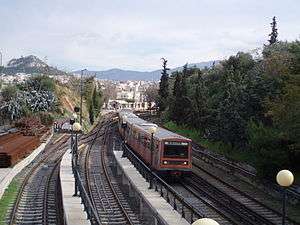 |
| T | 201-215 | |||||
| DT | 301-315 | |||||
| 9th | 1983–1985 | DM-M+M-DM | DM | 1101–1125 | 50 railcars made of aluminium LEW (type GIII) in EMU-4 sets later rearranged in EMU-6 (DM-M+M-DM+M-DM). In limited use after 1999 and all withdrawn until 2004. |  |
| M | 2201–2225 | |||||
| 10th | 1993–1995 | DM-T-DM+DT-DM | DM | 146-175 | 50 railcars made by MAN-AEG/Siemens-Hellenic Shipyards in EMU-5 sets. | |
| T | 216-225 | |||||
| DT | 316-325 | |||||
| 11th | 2000–2004 | DM-T-DM+DM-T-DM | DM | 3101-3180 | 120 railcars coupled in 20 EMU-6 trains. Made by ADtranz-Siemens-Hellenic Shipyards. Nine railcars were destroyed by terrorists at Kifissia station on 2009-03-02.[11] | 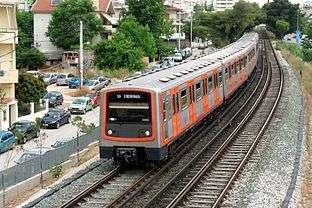 |
| T | 3201-3240 | |||||
Other rolling stock

In 1904 two electric locomotives, numbered 20 and 21, were bought from Thomson-Houston.
In 1911 the railway bought from Goossens two steeple-cab electric locomotives (numbered 31 and 32) and a self-propelled electric freight railcar (41), capable of operating from third rail or overhead line. These could operate over the Piraeus Harbour tramway, the Piraeus-Perama light railway as well as on the mainline to Thision and Omonoia. Freight railcar 41 was used initially to carry bags of transcontinental mail unloaded from passenger liners in Piraeus. Locomotive 32 is still in use, with the overhead collector removed.
In addition the railway owns a road-rail Unimog car and a ballast tamper.
During 1981-1984 ISAP leased six four-car, bright yellow trains of narrow loading gauge (type G-I or Gisela) from East Berlin's metro.
In the early 1980s consideration was given to the purchase of 60 secondhand cars of London Underground R Stock, built between 1938 and 1959, but ultimately no deal was made and new carriages were purchased instead.[12]
Piraeus rolling stock works

Athens & Piraeus Railway, in common with most railways of the steam era, had its own rolling stock heavy maintenance works, located next to Piraeus station. In 1926 this became property of E.I.S. In addition to maintenance, repair and rebuilding, Piraeus works constructed a significant number of railway cars, mostly between 1880 and 1960. The most significant projects were the construction of 12 electric rail cars in 1923 and the rebuilding of rolling stock destroyed by allied bombing in 1944.[13] Another noteworthy project was the construction of a small number of electric trams, based on a Dick Kerr model (1939).
An excellent example of the technical skill available at Piraeus works is the Royal Saloon (1888), a present to King George I of Greece. This luxurious vehicle was much admired and it was exhibited at the 1888 "Olympia Fair" (First Athens International Exhibition) held in Zappeion. The Royal Saloon survives to date, and is exhibited in the Railway Museum of Athens.
Proposed northern extension
An extension to the north was under consideration that would have been built in two phases, reaching Nea Erithrea by the end of the first phase and Agios Stefanos by the end of the second phase. Due to lack of funding, this extension was canceled in 2011.
Gallery
 Piraeus station, a historical sample of early 20th century industrial architecture
Piraeus station, a historical sample of early 20th century industrial architecture Preserved old EIS rolling stock at Piraeus Depot.
Preserved old EIS rolling stock at Piraeus Depot. Preserved electric locomotive no 32 and ballast tamper Y at Thision station sidings.
Preserved electric locomotive no 32 and ballast tamper Y at Thision station sidings.- ISAP train at the Ancient Agora of Athens.
See also
- Piraeus-Perama light railway
- Lavrion Square-Strofyli railway
- Attica Railways
- Athens Mass Transit System
- Athens Metro
- Line 1 (Athens Metro)
- Budapest–Belgrade–Skopje–Athens railway
References
- S.A.P./E.I.S. also constructed and operated the Piraeus Harbour Tramway (1908-1960) and the Piraeus-Perama light railway (1936-1977). These were also standard gauge and were used by freight and service S.A.P./E.I.S. trains.
- Law 352 (Gazette Vol A, issue 147, 16 June 1976)
- Law 2669/1988, Government Gazette Issue A 283/1998-12-18, Part 7, paragraphs 3 and 4.
- «Πράσινο» στο νομοσχέδιο για τις αστικές συγκοινωνίες Naftemporiki Newspaper, 2011-01-12.
- Law 3920, Government Gazette issue A-33, 2011-03-03.
- Ministerial Decision 28737/2637, Government Gazette issue B-1454, 2011-06-17
- Zartaloudis et al. 1997, p. 29.
- Durrant 1972, p. 51.
- Durrant 1972, pp. 50–52.
- Nathenas et al. 2007, p. 616.
- "Εμπρησμός σε βαγόνια του ΗΣΑΠ". HMERHSIA (IMERISIA) newspaper. 2009-03-03.
- Connor, Piers (1983). The 'R' Stock Story. Hemel Hempstead: London Underground Railway Society. p. 60. ISBN 0-9508793-0-4.CS1 maint: ref=harv (link)
- 130 Χρόνια Ηλεκτρικοί Σιδηρόδρομοι Αθηνών-Πειραιώς Α.Ε. (130 years of Athens-Piraeus electric railways). ISAP. 1999–2005. pp. 59, 132, 133. ISBN 960-86477-0-3.
- 130 Χρόνια Ηλεκτρικοί Σιδηρόδρομοι Αθηνών-Πειραιώς Α.Ε. (130 years of Athens-Piraeus electric railways). ISAP. 1999–2005. ISBN 960-86477-0-3.
- Durrant, A. E. (1972) [1966]. The Steam Locomotives of Eastern Europe. Newton Abbot, Devon, UK: David and Charles. ISBN 0-7153-4077-8.CS1 maint: ref=harv (link)
- Nathenas, G.; Kourbelis, A.; Vlastos, T.; Kourouzidis, S.; Katsareas, V.; Karamanis, P.; Klonos, A.; Kokkinos, N. (2007). Από τα Παμφορεία στο Μετρό (in Greek). 2. Athens: Μίλητος (Militos). ISBN 978-960-8460-91-1.CS1 maint: ref=harv (link)
- Zartaloudis, I.; Karatolos, D.; Koutelidis, D.; Nathenas, G.; Fasoulas, S.; Filippoupolitis, A. (1997). Οι Ελληνικοί Σιδηρόδρομοι (Hellenic Railways) (in Greek). Μίλητος (Militos). pp. 22–37. ISBN 960-8460-07-7.CS1 maint: ref=harv (link)
Further reading
| Wikimedia Commons has media related to Athens-Piraeus Electric Railways. |
- Ελληνικοί Ηλεκτρικοί Σιδηρόδρομοι 1869-1969 (Hellenic Electric Railways 1869-1969) (2nd ed.). Athens, Greece: Hellenic Electric Railways. 2005 [1970]. ISBN 960-86477-1-1.CS1 maint: ref=harv (link)